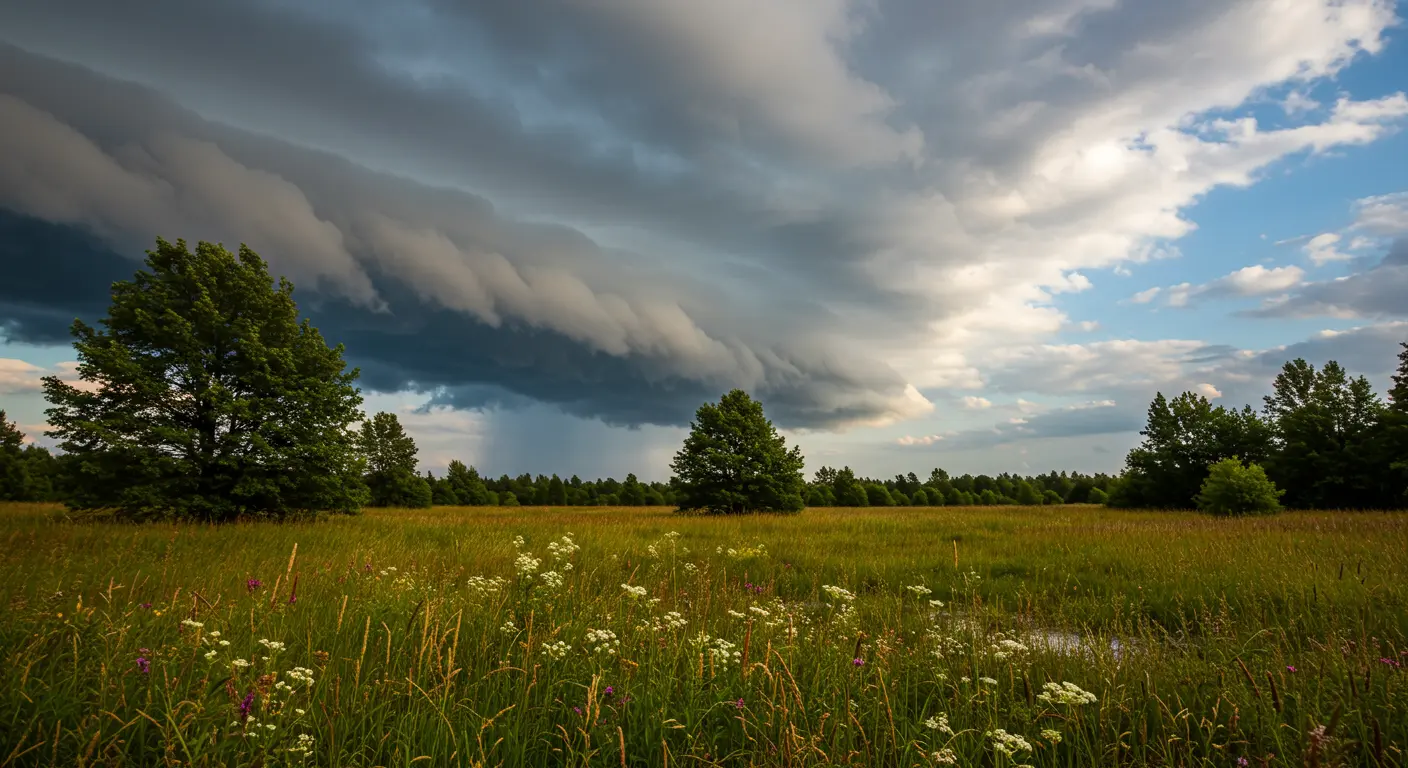Understanding Weather Associated with a Cold Front
What is a Cold Front?
A cold front marks the dramatic boundary where dense, cold air pushes beneath a warmer air mass, forcing the lighter warm air to surge upward rapidly. This dynamic process—frontal lifting—carves out a steeply sloped boundary within a trough of low pressure, creating intense weather activity.
Across the Northern Hemisphere, these weather systems typically charge from northwest to southeast at 15 to 30 miles per hour. Dramatic weather transformations follow in their wake.
Weather Patterns Associated with Cold Fronts
When a cold front sweeps through, it brings predictable yet dramatic weather changes:
-
Temperature Drop: Temperatures can fall sharply, often by 5-15°F (3-8°C) within an hour.
-
Wind Shift: Winds typically shift from a southerly direction to a westerly or northwesterly direction, often becoming gusty.
-
Pressure Change: Atmospheric pressure falls as the front approaches, hits a low point during passage, and then rises sharply.
-
Clouds and Precipitation: The forceful lifting of warm air creates a narrowband of towering cumulonimbus clouds, leading to heavy rain, thunderstorms, or squall lines.
-
Severe Weather: In unstable conditions, the frontal turbulence can generate large hail, damaging winds, and occasionally tornadoes.
-
Post-Frontal Clearing: After the front passes, the weather usually becomes cooler, drier, and clearer, though lake-effect snow or rain showers can occur if the cold air picks up moisture.
Precipitation Types Linked to Cold Fronts
The powerful lifting engine of a cold front can spawn various precipitation types, each shaped by the atmospheric conditions it encounters:
-
Thunderstorms: Often forming in a line (squall line), these storms are intense but brief, capable of producing heavy rain and flash flooding.
-
Hailstorms: Strong up drafts within thunderstorms can produce hail, with its size depending on the storm’s intensity.
-
Snow Squalls: In winter, fronts can cause brief but intense periods of heavy snow with strong winds, drastically reducing visibility.
-
Tornadoes: While less common, tornadoes can form where extreme instability and wind shear exist along the frontal boundary.
-
Post-Frontal Rain: Slower-moving fronts can be followed by wider bands of steady, moderate rain that may persist for hours.
The type and intensity of precipitation provide important information about a front’s speed and strength. This allows meteorologists to improve their forecasts and issue timely warnings.
Cloud Types Formed by Cold Fronts
Cold fronts create distinct cloud formations—each a telltale sign of the front’s approach, velocity, and the stability of the air mass being displaced.
-
Cumulonimbus: Towering, anvil-shaped thunderclouds that signal significant instability and produce severe weather. They are often preceded by growing Cumulus congests clouds.
-
Altostratus: Gray, sheet-like mid-level clouds that form in more stable conditions, typically producing steady, moderate precipitation.
-
Nimbostratus: Thick, dark, and uniform cloud layers associated with slower-moving fronts, resulting in prolonged periods of rain or snow.
-
Stratocumulus: Low, lumpy cloud layers that often appear behind a front, producing light drizzle or no precipitation.
-
Shelf Cloud (Marcus): A low, horizontal, wedge-shaped cloud along the leading edge of a squall line, signaling the arrival of strong winds.
Understanding these cloud patterns helps with forecasting a front’s fury and potential impacts.
Cold Fronts on Weather Maps
On weather maps, a cold front appears as a solid blue line adorned with filled triangles pointing toward its destination—clearly marking where weather changes will occur.
Across the mid-latitudes, these weather-makers typically march from west to east or northwest to southeast. Yet their paths can twist and turn, influenced by larger high and low-pressure systems.
The spacing of triangles hints at the front’s intensity—tightly packed triangles signal a fierce front, while wider spacing suggests a gentler passage. Modern maps often layer on color shading to reveal precipitation patterns or temperature gradients, adding rich detail to the story.
Weather maps also trace a front’s projected journey through time, helping meteorologists track its speed and predict its arrival across different regions. For the complete picture, they’re displayed alongside pressure systems, warm fronts, and other atmospheric players.
Impact of Cold Fronts on Local Weather
The most noticeable change is a sharp temperature plunge. As the cold air mass moves in, temperatures can nosedive by 5-15°F (3-8°C) within a single hour—sometimes plummeting a staggering 30°F (17°C) over 24 hours.
The vertical displacement of warm air creates substantial weather activity. Warm air, thrust upward along the frontal boundary, cools and condenses into clouds, frequently triggering precipitation.
When conditions turn particularly volatile, severe weather can erupt. Thunderstorms frequently bloom along cold fronts, sometimes organizing into formidable squall lines—continuous walls of storms stretching hundreds of miles along the frontal boundary.
Beyond the obvious precipitation and temperature drama, cold fronts also cause precise changes in barometric pressure and humidity. Pressure typically drops as the front approaches, bottoms out during passage, then rockets upward in its aftermath.
Cold fronts rarely work alone—they’re intimately connected to larger low-pressure systems that can amplify their local weather impacts. These parent low-pressure systems enhance upward air motion, further fueling cloud development and precipitation. The intricate relationship between cold front and parent system ultimately determines how long the turbulent weather persists and how far its influence spreads across a region.
Frequently Asked Questions about Cold Fronts
Understanding how cold fronts work helps you better prepare for weather changes. Here are answers to the most pressing questions about these atmospheric powerhouses:
What exactly happens during a cold front passage?
Imagine this process: cold, dense air wedges beneath a warmer air mass, forcing the warm air skyward. As this warm air rises and cools, it spawns clouds and often triggers precipitation, temperature drops, and dramatic wind shifts.
How quickly do temperatures change when a cold front moves through?
Temperature changes can be dramatic: temperatures can plummet 5-15°F (3-8°C) within a single hour. Winter fronts can be even more brutal, with temperatures crashing 30°F (17°C) or more over 24 hours.
Why do cold fronts often bring severe weather?
Here’s why: the rapid, forceful lifting of warm, moist air creates explosive instability. This can unleash powerful thunderstorms, destructive winds, hail, and occasionally tornadoes—particularly when the front crashes into exceptionally warm, humid air.
Can you predict when a cold front will pass through your area?
Absolutely. Modern meteorologists can pinpoint cold front arrivals 1–3 days ahead using sophisticated weather maps, satellite imagery, and radar technology. That distinctive blue line with triangles on weather maps? It’s your roadmap to the front’s location and trajectory.
How long do the weather effects of a cold front typically last?
The active weather—thunderstorms and intense conditions—usually lasts just 1–3 hours at any location. But the cooler, drier air mass that follows? It can settle in and stay for several days.
Do cold fronts always bring precipitation?
No. If there is not enough moisture in the air being lifted, a cold front can pass with only a wind shift and temperature drop. This is known as a ”dry front.”
What’s the difference between a cold front and a warm front?
Cold fronts move quickly and create steep boundaries where cold air rapidly displaces warm air, leading to intense, short-lived weather. Warm fronts move more slowly, with warm air gradually rising over cold air, creating gentler slopes and longer periods of lighter precipitation.


